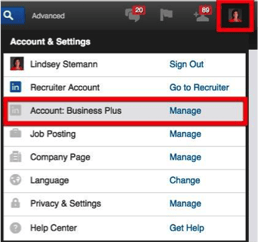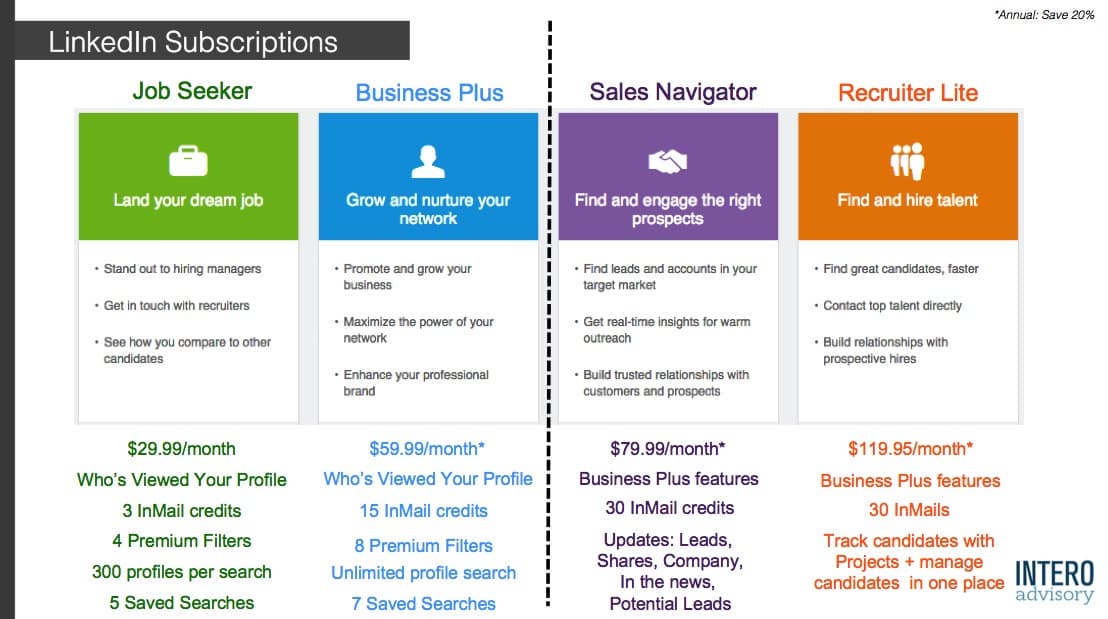Listen to the recorded version of this blog post here:
It has been more than a year since I last wrote on the topic of LinkedIn subscriptions, and with recent updates to these levels, I owe you an update. With more than 12,000 views of my previous post, it is clear that these are still common questions that LinkedIn members are asking:
- Is it really worth upgrading my LinkedIn account?
- I’m assuming I can’t do much of anything without paying for LinkedIn, right?
- I pay for my LinkedIn subscription, but I have no idea what I’m getting for it. How do I find out?
- I just joined LinkedIn, should I upgrade to a paid subscription level?
To find out which LinkedIn subscription you are on, simply hover over your Profile picture in the top right corner of your account, then click on “Account: Manage.”

There are 5 types of LinkedIn subscriptions:
- Basic (free)
- Job Seeker
- Business Plus
- Sales Navigator
- Recruiter Lite
I put this image together to help easily distinguish the differences between the paid LinkedIn subscription levels:

On the Basic (free) version, you get:
- Limited insight into Who’s Viewed Your Profile
- No InMail credits
- No Premium Search Filters
- 100 profiles per search
- 3 Saved Searches
Let’s dive into understanding what these features actually mean for you:
- Who’s Viewed Your Profile: Get a more complete picture of who is looking at your profile when you upgrade. Do you have your Settings set to be anonymous when you look at other profiles? Guess what – LinkedIn says when you are on the free version and want to check out who is viewing your profile, LinkedIn will hide that information since you are not being transparent with your network. Remember this setting is dynamic. It is often beneficial to share your name and headline when viewing other people’s profiles. Plus, viewing Profiles is the #1 activity on LinkedIn. When you notice someone has visited your Profile, take action on that activity; reach out to them and start a conversation.
- InMail Messages: InMails allow you to message individuals who you may not want to connect directly with yet. LinkedIn messages have an 85% open rate over basic email; so tapping into these InMails can be a big advantage to starting conversations more quickly. If the recipient accepts or declines your InMail within 90 days, LinkedIn will credit the InMail back to you. Check out my colleague, Erin Miller’s post about InMails and take the InMail challenge she proposes.
- Premium Search Filters: Want to refine your searches and get to the right people more quickly? Various LinkedIn subscription levels include: seniority level, company size, interests, Fortune 1000, job function, years of experience, additional information about your groups and who is new to LinkedIn.
- Profiles Per Search: Last year LinkedIn allowed Basic (free) members access to 3rd degree Profiles. This access came at an expense: the commercial search limit. Over the course of the month, if you are on the free subscription OR the Job Seeker LinkedIn subscription, and you are searching a lot you may be notified of approaching your commercial search limit. As of the date this article was published, there is no commercial search limit when you upgrade to the Business Plus subscription or higher.
- Saved Search Alerts: The Saved Search Alerts are one of (three) emails you don’t want to miss in your inbox. LinkedIn will email you any new profiles that fit your search criteria on a weekly basis. So, LinkedIn will email you leads? Yep, you got it.
Let’s revisit the image I put together to compare the paid LinkedIn subscription levels:

Notice the black vertical line separating the levels. I added this line to point out that Sales Navigator and Recruiter Lite are separate interfaces; meaning, you will still have your individual “regular” LinkedIn account, but to use either of these subscriptions, LinkedIn will toggle you to a new Internet browser window. There will be a learning curve, but we train on Sales Navigator and Recruiter Lite if you need it.
Also worth mentioning, we recently noticed that, in LinkedIn’s approach to simplify their subscription levels, they retired an older subscription called Sales Plus. (The article is worth a quick read if you still have that LinkedIn subscription).
I hope you have more clarity on the important features you acquire when you upgrade your account. Already upgraded? What is your favorite LinkedIn Premium feature?
My colleague, Colleen McKenna, said it best: “You can be successful, network and create new opportunities with a Basic account, but if you really want to leverage the power and depth of LinkedIn, upgrade to a LinkedIn Premium Account.”


